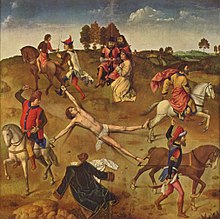| Method |
Description
|
| Animals |
- Crushing by elephant.
- Devouring by animals, as in damnatio ad bestias (i.e., as in the cliché, "being thrown to the lions"), as well as by alligators, crocodiles, piranha and sharks.
- Stings from scorpions and bites by snakes, spiders, etc. (e.g. the "Snake pit" of Germanic legend)
- Tearing apart by horses (e.g., in medieval Europe and Imperial China, with four horses; or "quartering", with four horses, as in The Song of Roland and Child Owlet).
- Trampling by horses (example: Al-Musta'sim, the last Abbasid Caliph in Baghdad).
|
| Back-breaking |
A Mongolian method of execution that avoided the spilling of blood on the ground (example: the Mongolian leader Jamukha was probably executed this way in 1206).
|
| Blowing from a gun |
Tied to the mouth of a cannon, which is then fired.
|
| Boiling to death |
This penalty was carried out using a large cauldron filled with water, oil, tar, tallow, or even molten lead.
|
| Breaking wheel |
Also known as the Catherine wheel, after a saint who was allegedly sentenced to be executed by this method.
|
| Buried alive |
Traditional punishment for Vestal virgins who had broken their vows.
|
| Burning |
Most infamous as a method of execution for heretics and witches. A slower method of applying single pieces of burning wood was used by Native Americans in torturing their captives to death.
|
| Cooking |
Brazen Bull
|
| Crucifixion |
Roping or nailing to a wooden cross or similar apparatus (such as a tree) and allowing to perish.
|
| Crushing |
By a weight, abruptly or as a slow ordeal.
|
| Decapitation |
Also known as beheading. One of the most famous execution methods is execution by guillotine.
|
| Disembowelment |
Often employed as a preliminary stage to the actual execution, e.g. by beheading; an integral part of seppuku (harakiri), which was sometimes used as a form of capital punishment.
|
| Dismemberment |
Being drawn and quartered sometimes resulted in dismemberment.
|
| Drawing and quartering |
English method of executing those found guilty of high treason.
|
| Electrocution |
The electric chair.
|
| Falling |
The victim is thrown off a height or into a hollow (example: the Barathron in Athens, into which the Athenian generals condemned for their part in the battle of Arginusae were cast). In Argentina during the Dirty War, those secretly abducted were later drugged and thrown from an airplane into the ocean.
|
| Flaying |
The skin is removed from the body.
|
| Garrote |
Used most commonly in Spain and in former Spanish colonies (e.g. the Philippines), used to strangle or choke someone.
|
| Gas |
Death by asphyxiation or poison gas in a sealed chamber.
|
| Gibbeting |
The act of gibbeting refers to the use of a gallows-type structure from which the victim was usually placed within a cage which is then hung in a public location and the victim left to die to deter other existing or potential criminals.
|
| Hanging |
One of the most common methods of execution, still in use in a number of countries.
|
| Immurement |
The confinement of a person by walling off any exits; since they were usually kept alive through an opening, this was more a form of imprisonment for life than of capital punishment (example: the countess Elisabeth Báthory, who lived for four more years after having been immured).
|
| Impalement |
|
| Keelhauling |
European maritime punishment.
|
| Poisoning |
Lethal injection. Before modern times, sayak (사약, 賜藥) was the method of capital punishment of nobles (yangban) and members of the royal family during the Joseon Dynasty in Korea due to the Confucianist belief that one may kill a seonbi but may not insult him (사가살불가욕, 士可殺不可辱).
|
| Pendulum |
A type of machine with an axe head for a weight that slices closer to the victim's torso over time. (Of disputed historicity.)
|
| Sawing |
(Of disputed historicity.)
|
| Scaphism |
|
| Shooting |
|
| Slow slicing |
|
| Starvation / Dehydration |
Immurement
|
| Stoning |
The condemned is pummeled by stones thrown by a group of people with the totality of the injuries suffered leading to eventual death.
|
| Strangulation |
|
| Suffocation in plaster |
Gatch gereftani
|
| Suffocation in ash |
|
